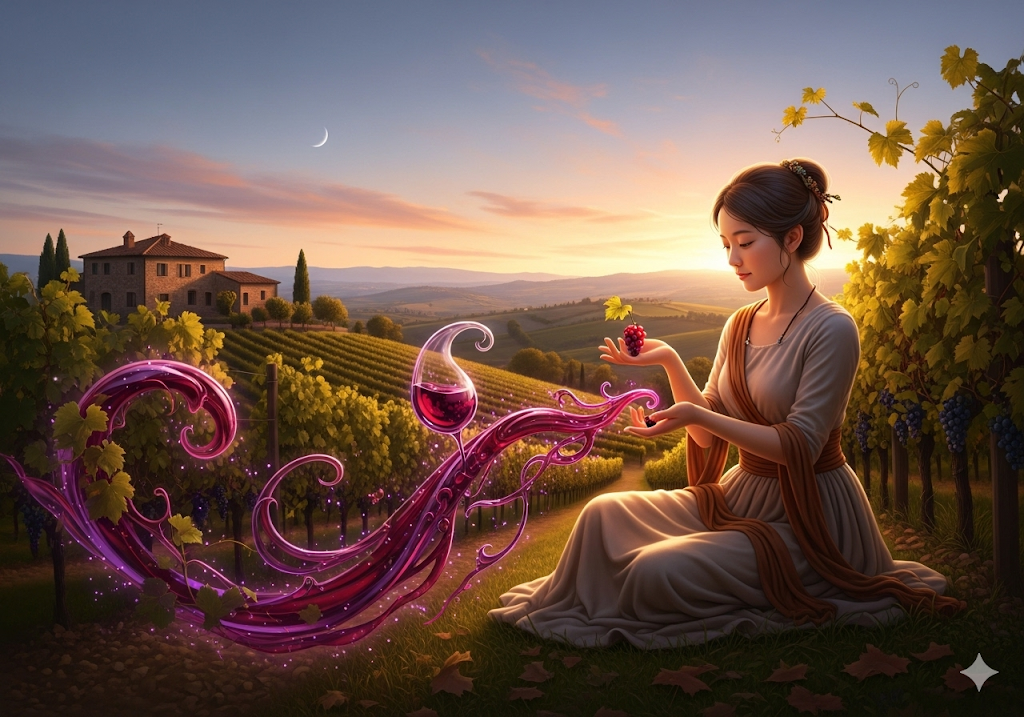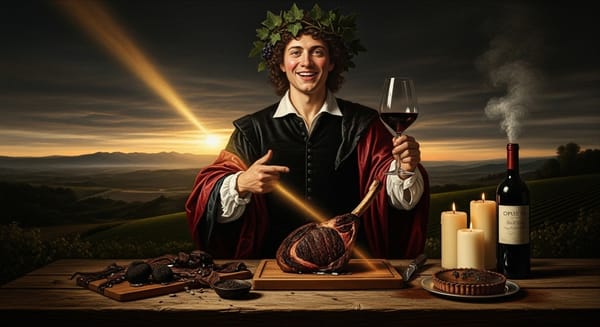The Art of Patience: Uncorking the Magic of Brunello di Montalcino
Brunello di Montalcino is a legendary Tuscan wine crafted from 100% Sangiovese Grosso grapes. This guide explores its unique terroir, rich history from Biondi-Santi to modern legends, and the rigorous winemaking process that creates its profound, age-worthy character.

Brunello di Montalcino begins with a tremor beneath the clay-limestone soils of Tuscany’s southern crest. On autumn mornings, fog waltzes up from the Orcia River like a scrim, softening the fortress town of Montalcino into a charcoal sketch. Cypress spires pierce the hush, and somewhere a pruning shear snaps, releasing the green-pepper scent of Sangiovese Grosso canes. If you lean close enough, the earth seems to exhale crushed rose petals and warm terracotta—an ancient vow to anyone patient enough to listen.
What sets this hill apart is not altitude alone (though vineyards climb to 500 meters, thrilling the kestrels) but the region’s peculiar tug-of-war between Tyrrhenian breezes and continental currents. One moment the air tastes of salt spray; the next, of frost. This teasing dance slows the ripening of Brunello’s thick-skinned berries, threading high-pitched acidity through a wine famous for baritone depth. Every bottle carries that tension like a violin string drawn taut—ready to sing for decades.
The Ferment of History
The story properly opens in 1865 when Ferruccio Biondi-Santi returned from Garibaldi’s Wars, pockets jangling with ironies and ambitions. He dared to vinify a single Sangiovese clone, dubbing it “Brunello” for its dark complexion. In an era of chaotic field blends, the idea felt almost heretical—yet Ferruccio foresaw a future where purity would trump abundance. His first cellar trials were secretive; even the moonlight seemed conspiratorial as he racked the wine under flickering lanterns. By 1888, the inaugural commercial Brunello emerged, stern as a general yet perfumed like a wedding bouquet.
World wars, phylloxera, and economic ruin battered Montalcino, but Ferruccio’s grandson Franco Biondi-Santi guarded the legacy with near-monastic intensity. He pruned to agonizingly low yields, aged the wines longer than law required, and spoke of Brunello in near-liturgical cadences. Collectors whispered that a single sip from his Riserva could detonate memories you’d never lived. Even today, when a venerable Biondi-Santi cork creaks free, the room stills as though turning a page in an illuminated manuscript.
From Ferruccio’s Vine to Modern Legends
While the Biondi-Santis wrote the prologue, a constellation of contemporaries now sketches the sequel—each interpreting Brunello’s melody in a new key.
Valdicava: Thunder in Velvet
North of town, Valdicava sprawls beneath the Abbey of Sant’Antimo’s Romanesque silhouette. Winemaker Vincenzo Abbruzzese favors extended macerations and larger Slavonian oak, coaxing violet-scented thunderclouds into the glass. When you taste Valdicava, blackberry and anise surge like timpani, yet tannins land as soft as suede gloves. It’s the paradox that keeps cellars humming with expectation.
Casanova di Neri: The Mercury Line
Closer to the Asso River, Giacomo Neri pushes ripeness to the very ledge, harnessing darker fruit and polished French barriques. His Tenuta Nuova bottling floods the palate with black-cherry liqueur, cacao nib, and the flicker of sweet tobacco. Critics have showered perfect scores like confetti, but the estate remains restless—each vintage feels like a dare to the next.
Soldera: A Lone Wolf’s Gospel
The late Gianfranco Soldera at Case Basse viewed Brunello as a living organism. Biodiversity, he argued, was not a marketing hook but a moral duty; even spiders earned sanctuary in his vineyard’s micro-cosmos. Fermentations unfolded spontaneously in open-top tini, yielding wines that taste simultaneously primordial and aerodynamic—rosewater, wild fennel, wet stone, and something untamed as a wolf’s howl at dawn. Soldera shunned the DOCG designation, bottling under “Toscana IGT” after a scandalous cask-tampering incident in 2013. Yet devotion to the name persists; collectors now speak of Soldera not as brand but gospel.
Poggio di Sotto: The Silk Whisperer
Down in Castelnuovo dell’Abate, Poggio di Sotto courts a lighter, aromatic expression. At harvest, bunches scarcely stain the hands, yet the resulting wine swirls like garnet silk—cranberry, dried rose, orange peel, and that telltale Montalcinese iron filing. Open a bottle alongside grilled Chianina steak, and watch conversation pivot from small talk to confessions.
Rising Voices
Names like Le Ragnaie, Stella di Campalto, Salvioni, and Fuligni compose the region’s modern chorus. Each calibrates oak, altitude, and picking dates with surgical precision, yet leaves fingerprints distinct enough to spot in a blind lineup. What unites them is reverence for Sangiovese’s storytelling capacity—one that never shouts but quietly accumulates gravitas with every passing season.
A Walk Through the Cellars
Step inside an aging room and the air thickens with primal aromatics: balsamic drizzle, fallen leaves, and the sweet funk of old oak staves. Barrels, some taller than men, line up like a terracotta army awaiting resurrection. Winemakers tap them with rubber mallets—listening for flaws as monks once listened for God. In these dim corridors, years evaporate. A 2019 Brunello slumbers beside a 1995 Riserva; both seem equidistant from eternity.
The cellarmaster’s dog may weave between your ankles, snout dusted with cobwebs, as if also tasting the decades. You grasp how time here is not a river but a circular tide, pulling memories forward even as it retreats. When finally a thief glass captures a translucent ruby, you nose pepper, rose, and orange oil—scent markers that feel less like notes than directions home.
Winemaking: From Vineyard to Vessel
Beneath the romance of castle walls and cypress-lined drives lies a rigorously codified craft. By law, Brunello must be 100 percent Sangiovese Grosso and cannot debut until the January five years after harvest (six for Riserva). At least two of those years must unfold in oak—traditionally giant Slavonian botti that breathe slowly, trading volume for patience.
Yet modern cellars reveal a spectrum of philosophies. Traditionalists favor 30- to 60-hectoliter casks whose staves smell of cedar shavings and history. Long, cool fermentations (often with native yeasts) stretch over 25–40 days, extracting phenolics at a meditative pace. Pump-overs replace punch-downs, gentling the cap like a lullaby. The resulting wines carry translucent color and an almost Burgundian perfume: sour cherry, rosehip, saddle leather.
Innovators, by contrast, experiment with truncated macerations and French tonneaux or barriques, chasing silkier tannins and darker fruit. Fermentations may start with cultured yeasts, the temperature nudged higher for a burst of color and glycerol. Micro-oxygenation, once heresy, now whispers through stainless lines in a few avant-garde chai, rounding edges without obvious oak seasoning.
Regardless of camp, nearly everyone green-harvests in July to curb yields to around 35 hectoliters per hectare. The September pick is a choreography of dawn-lit sorting tables, where clusters flicker past UV lamps that reveal hidden botrytis. Only pristine berries earn the right to ferment; everything else joins the compost heap.
After élevage, wines rest a mandatory four months in bottle, though many producers let gravity stretch that sabbatical to a year. Some estates, like Salvioni, swear the extra glass-time knits tannins into lace; others rely on it as a final safety check against mercurial brettanomyces. The common denominator is patience—no Brunello worth its salt rushes to market.
The Quiet Language of Vintages
No two years translate the hill’s dialect the same way. The sun-splashed 2015s strutted with operatic fruit, while 2016 etched graphite lines around balsamic depth—think Caravaggio chiaroscuro. By contrast, the cooler 2018s whisper in watercolor strokes: pomegranate, dried herb, and the snap of porcelain. Then came 2019 and 2020, each shouldering climate-change extremes yet—in Montalcino’s alchemical manner—fashioning balance from chaos.
Seasoned drinkers learn to read these shifts the way farmers read cloud cover: not as hieroglyphs but as weather forecasts for flavor. A sun-baked year cranks up plum compote and tannic muscle; a cooler season threads violet-laced acidity and cedar spice. Either way, Brunello’s bones remain unmistakably its own—iron-rich structure, flute-like acidity, tannins sculpted for the long march.
Collectible Allure: Investment Reflections
Across auction rosters, Brunello has graduated from “interesting Italian red” to blue-chip mainstay. Scarcity helps: vineyards cover barely 2,100 hectares—smaller than Bordeaux’s Margaux commune. Combine that with mandatory minimum aging and you have built-in bottle reduction before the first cork pops.
Historically, labels like Biondi-Santi Riserva and Soldera Case Basse Riserva see compound value appreciation that rivals First-Growth Bordeaux. Yet volatility exists: vintage hype cycles, critical scores, and global macro whispers can jostle prices. Collectors who treat Brunello solely as a trading chip risk missing its deeper dividend—the slow unfurling of tertiary nuance: truffle, sandalwood, dried fig, often emerging around year fifteen.
For newcomers, diversification may start with mixed cases from reputable houses across contrasting vintages—say, a muscular 2015 Valdicava, an ethereal 2018 Le Ragnaie, and a cerebral 2016 Poggio di Sotto. Store them in temperature-stable darkness (12–15 °C) and humidity near 70 percent. Track provenance obsessively; Brunello forgives many sins except poor storage. Above all, view each bottle less as stock certificate than as ticket to a future revelry where stories, not spreadsheets, carry the night. (These musings, of course, are observational—not individualized financial counsel.)
The Taste That Remembers You
Pour a young Brunello into a wide-bellied glass and the color flares ruby toward garnet, like embers banked under ash. Swirl, and tears descend the bowl at contemplative speed—telling of alcohol’s heft but also of glycerol grace. First aromas might recall crushed amarena cherries, dried lavender, and the whiff of new leather; then come subtler echoes—gunflint, Earl Grey, maybe even the memory of a childhood pencil case.
On the palate, the wine strides in measured tempo: fruit first, then spice, then minerals that feel almost electrical. Tannins cling like the after-touch of velvet against skin, never abrasive but insistently present, promising longevity. Acidity slices through the richness, sharpening contours the way mountain sunrise cuts shadow from cypress trunks. Long after swallowing, a bittersweet afterglow flutters—like recalling a farewell kiss when the train has already vanished around the bend.
Final Sip
Brunello di Montalcino is not a wine you merely taste; it is one that seems to taste you back, mapping your memories for places to echo. It teaches patience—five winters in barrel, another ten in bottle—and rewards those who honor the tempo. Yet even in youth, it offers a glimpse of its coming grandeur, the way a half-drawn curtain hints at sunrise.
Standing on the fortress ramparts at dusk, you may watch the last light gild the vineyard rows while church bells toll from Sant’Agostino. In that moment, melancholy drapes the hills like a velvet cloak—yet under it thrums exuberance: the laughter of harvest crews, the pop of corks, the simple miracle of a vine coaxing joy from stone. Brunello embodies that duality, pouring both longing and celebration into a single stem. Sip, and you carry the hill within you, wherever the next horizon leads.





